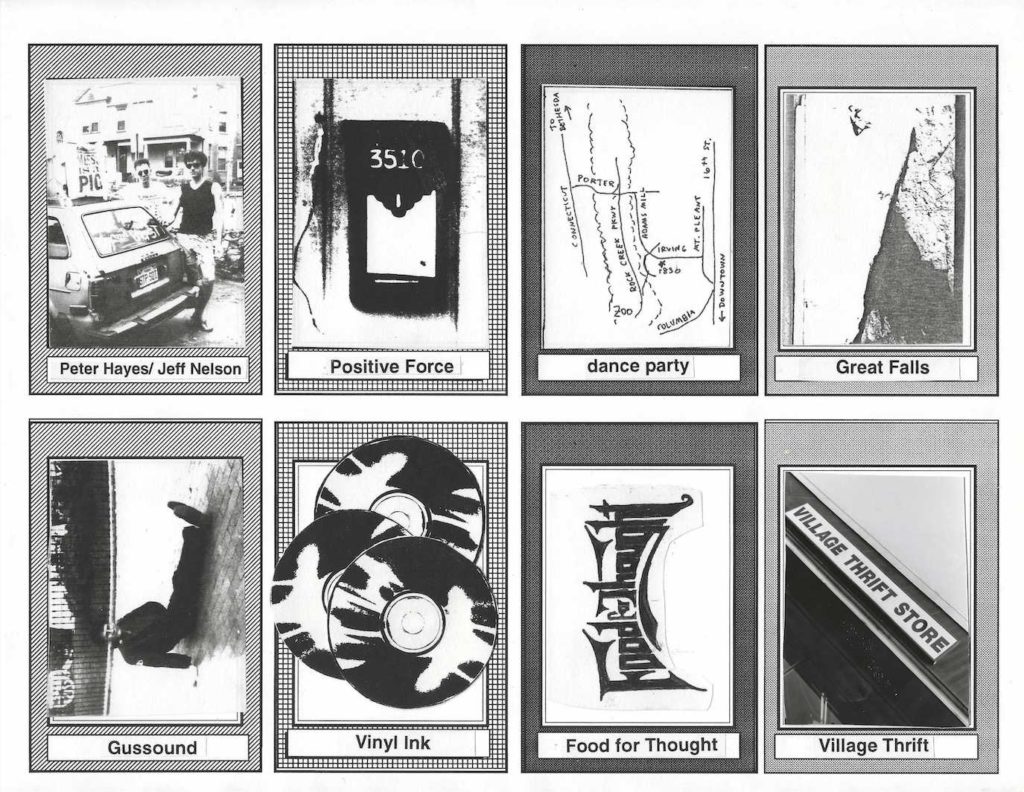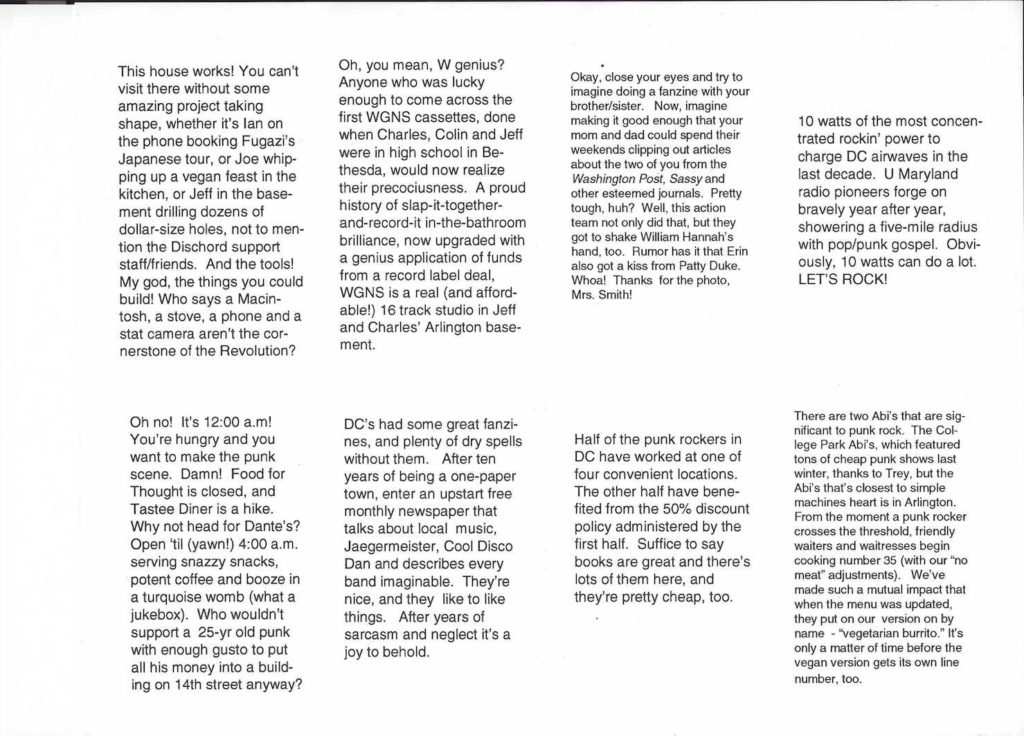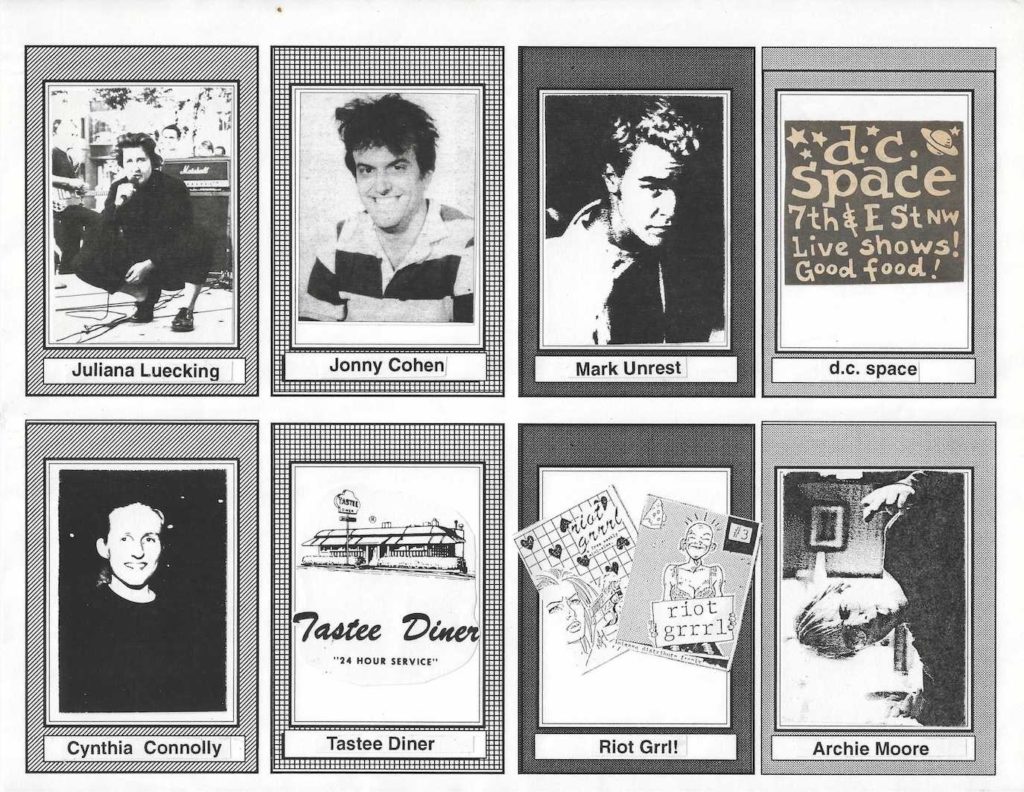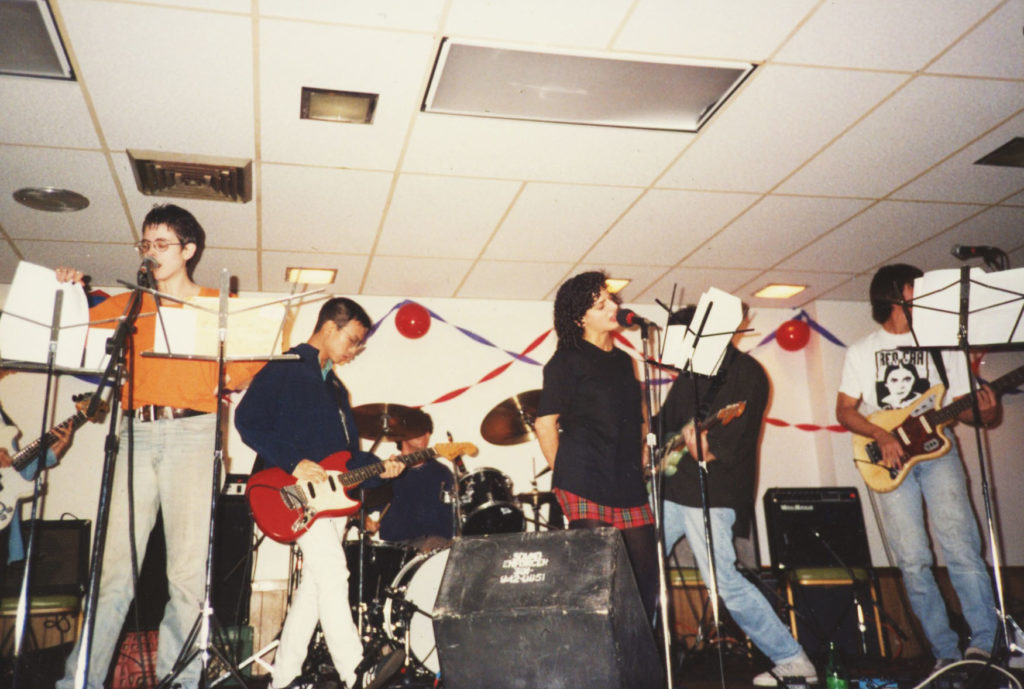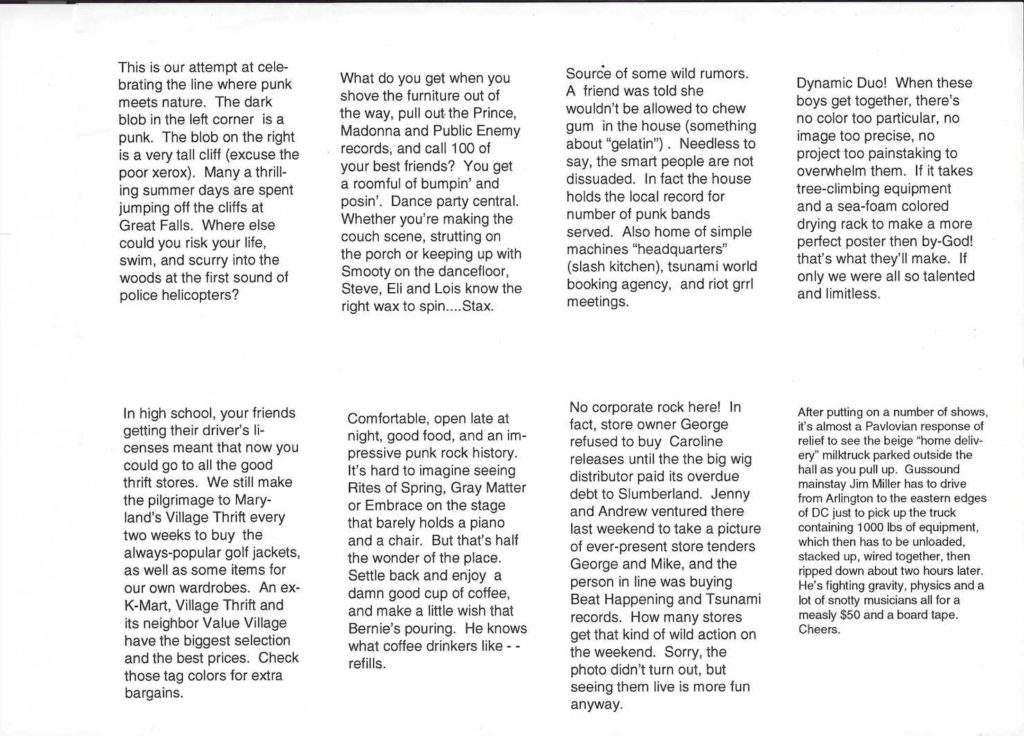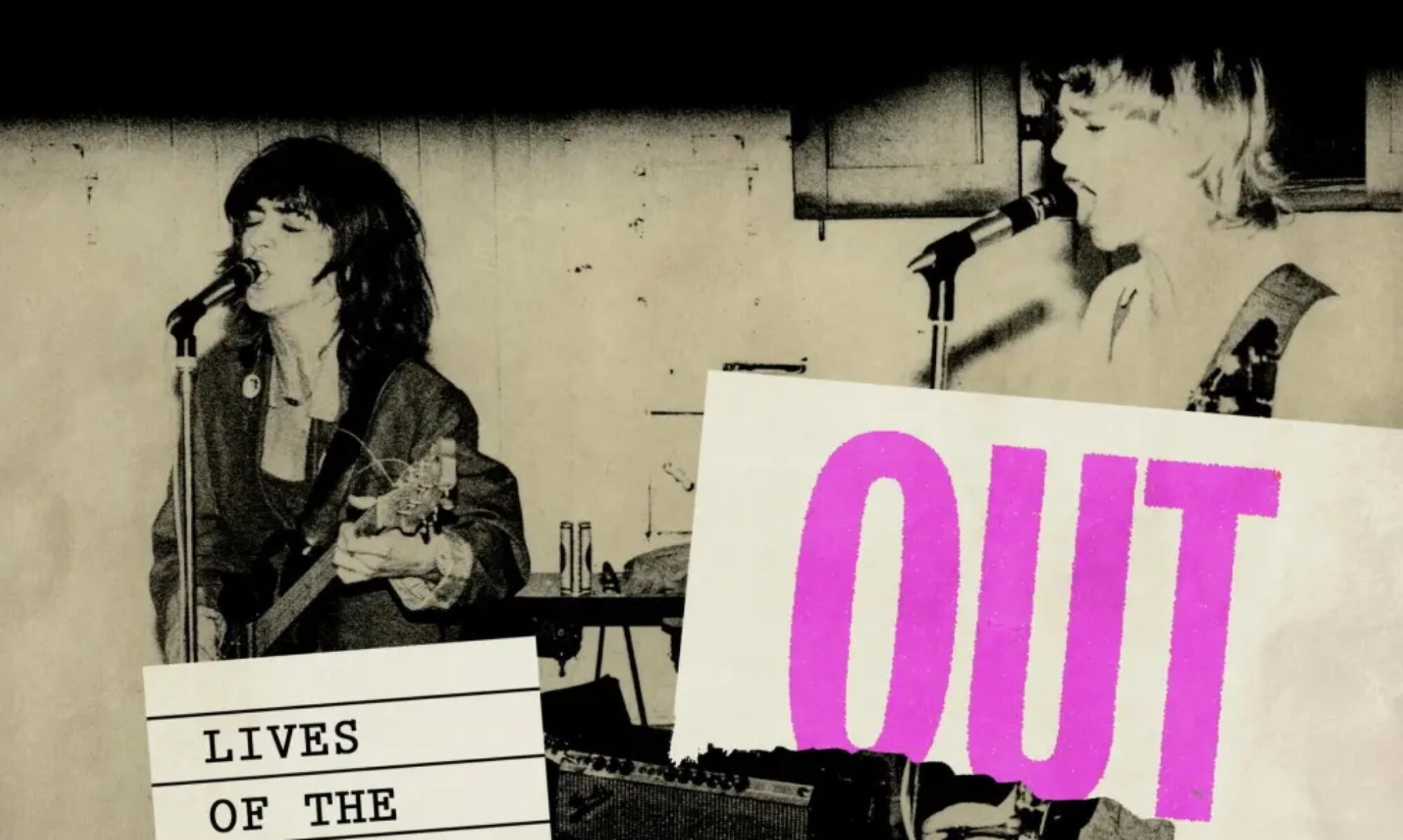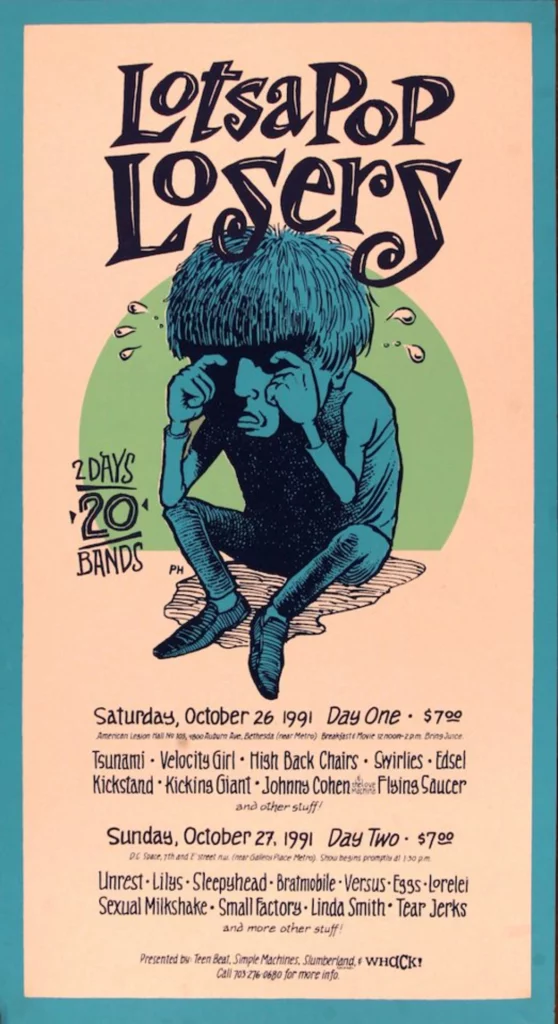
Lotsa Pop Losers was a two-day music festival that took place at the American Legion Hall in Bethesda, Maryland on October 26, 1991, and the late d.c. space on October 27, 1991. Organized by three young independent labels in D.C. (Simple Machines, Slumberland and Teen-Beat), the festival was clearly inspired by the International Pop Underground Convention while also reflecting an East Coast pop/punk/indie/etc. music scene that felt pretty damn awesome at the time. The lineup was:
Saturday: Jonny Cohen, Swirlies, Kickstand, Lois Maffeo, Kicking Giant, Flying Saucer, Tsunami, Velocity Girl, Edsel, High Back Chairs
Sunday: Lorelei, Versus, Tear Jerks, Eggs, Lilys, Linda Smith, Sexual Milkshake, Small Factory, Sleepyhead, Unrest
We checked in with the organizers (Jenny Toomey + Kristin Thomson from Simple Machines and Tsunami; Mark Robinson from Teen-Beat and Unrest) and some performers Erin Smith (who played with Unrest at the event) and Michael Galinsky (Sleepyhead) to see what they could remember about the fall festival three damn decades ago. —Compiled by Gail O’Hara
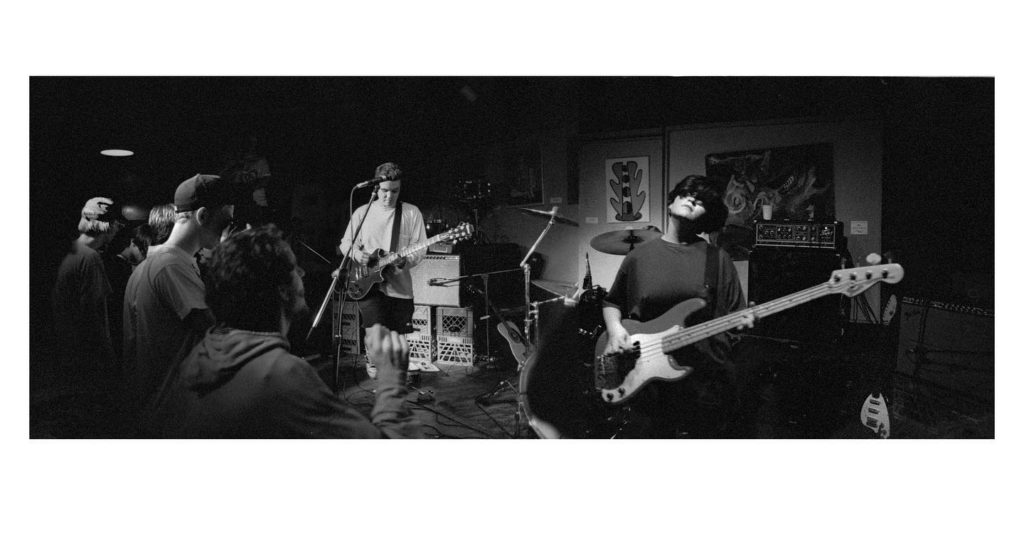
Did you attend Lotsa Pop Losers? What made you want to go?
Mark Robinson (Teen-Beat, Unrest): I did. The bands, the people, the fun.
Erin Smith (Bratmobile, Teenage Gang Debs): Of course! It was a no-brainer that I was going to go. The 3 labels involved were some of my favorites, and the scene then was relatively small and insular—it seemed like all of my friends were playing! Plus, I am from Bethesda—and it was just too cool that one entire day of the fest was going to be held there. I’m very into Bethesda punk history. It might blow people’s minds now, but there were punk shows and venues in Bethesda, and certainly plenty of punks from there. I was very proud to introduce out of town visitors like Kicking Giant to my hometown!
Michael Galinsky (Sleepyhead): Sleepyhead played and a lot of our friends were also playing. I can’t remember where we stayed, but I do remember that Otis Ball came with us. In NY we played with Kicking Giant, Versus, and Flying Saucer a lot so I think we were the NY contingent. We also played with Small Factory and I guess that made us the Northeast contingent. We had also played quite a few shows with the bands like the Swirlies and Eggs.
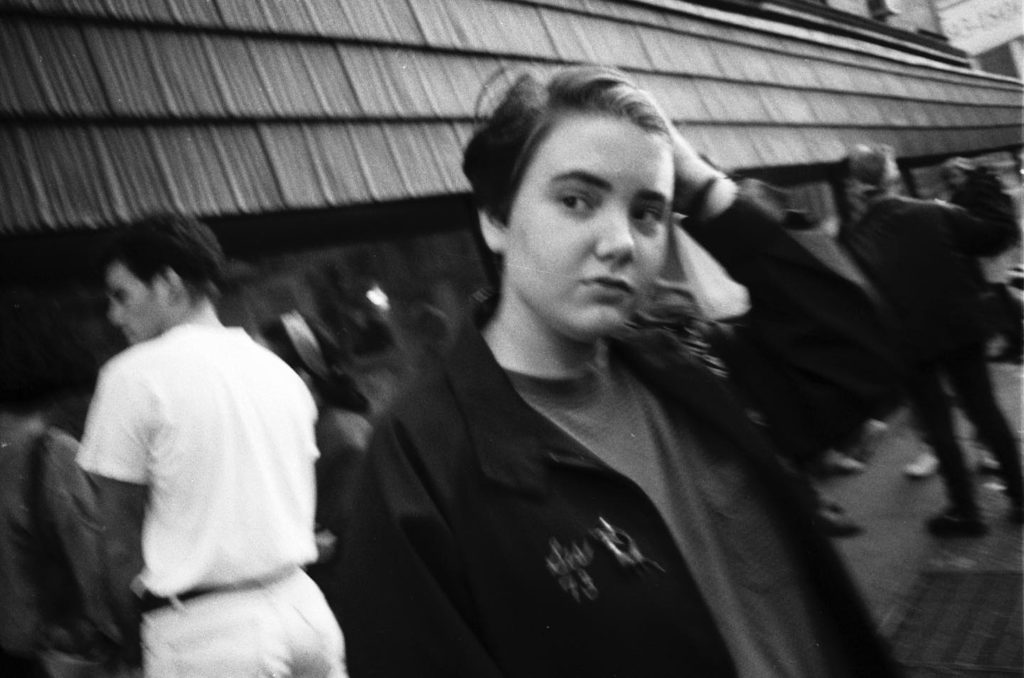
Were there other festivals like this you’d been to before? How was this different?
Erin: I had been to IPU (International Pop Underground Convention), which had just happened in Olympia, WA, 2 months before, in late August, 1991, with I believe only Kicking Giant, Sleepyhead, and Lois playing both fests. This was kind of cool in that it was 20 bands condensed into 2 days—so one long day in Bethesda at the American Legion Hall, and one long day in DC at dc space. It gave us a lot of time to all hang out together in one place!
Mark: I think this was probably my first festival like this. Maybe my first music festival of any kind.
Michael: We had also played at IPU and Lollipops and booze in Cambridge. This was more akin to IPU on a somewhat smaller scale. This was a bit more intimate and it was different for us because by this point we knew a lot more people so it was more like a reunion than being overwhelmed by a ton of new people. Somehow we were given a really prime spot on the bill. This was maybe the only time we played with Unrest, a band that I had a really profound respect for, so that had some meaning.
Kristin Thomson (Simple Machines Records / Tsunami): Yes! We’d just attended—and Tsunami had played—at the International Pop Underground in Olympia, WA in August 1991.
Jenny Toomey (Simple Machines Records / Tsunami): I’m sure we were inspired by IPU. We’d been to festivals before, but nothing as organized, three dimensional or as delightfully weird, as IPU. I’d spent 6 weeks in Olympia the previous summer after my first band Geek had toured the US with Superchunk and Seaweed. Aaron Stauffer talked me into coming back west and Candice was traveling so I rented her apartment and was living in the heart of the scene. So I’d experienced the strange time travel of the place up close. There were ways that Olympia was a north star and felt like it was way out ahead of the rest of the world, super feminist, queer positive, everyone was an artist and there were so many folks building and experimenting together—so much possibility. It was absolutely utopic. But there was also this darker, retro backward flavor to the town as well, a bizarro element, like a sci-fi novel where you walk through a time door and everything is cherry pie on the surface and sneaky drugs and violence and grudges underneath. Beat Happening had that mix in spades, like a caramel apple with a razor blade center. I think IPU was so great because it had that depth. It wasn’t just twee “hey, let’s do something fun and pretty”; it had a combination of bands and events and happenings that stretched across all that territory. Things that were public and celebrated and joyful and things that were hidden and dark. It was also so various; it had a “choose your own adventure” element. Some of the things I remember most was the happenstance of the event and have equal weight to the shows. Like, being in line at the grocery store between a Melvin and Jad Fair. Having to pitch a tent in the Capitol Theater because the recycling room in the Martin Apartments where you thought you were going to sleep was already taken by (I think) David Lester, and the Capitol Theater was full of fleas.
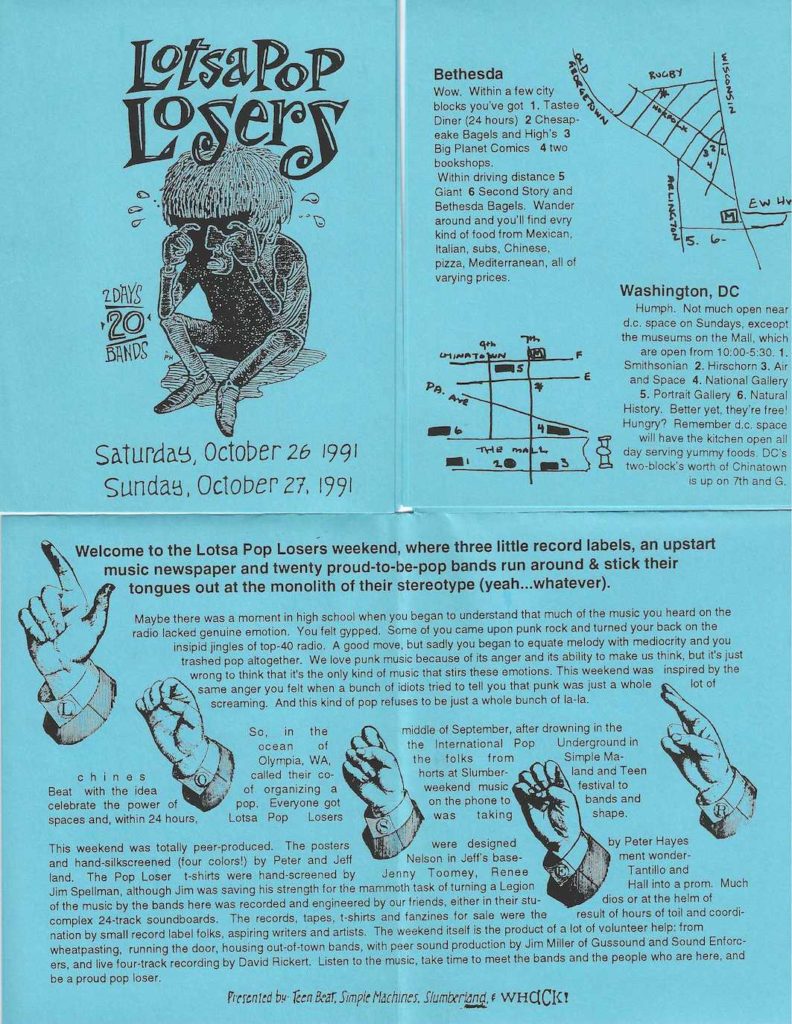
Kristin: There were so many parts of IPU that I loved. The Melvins playing an outdoor afternoon show. The Cake Walk. The Planet of the Apes movie day. And, honestly, one of the most emotionally raw Fugazi shows I ever witnessed. I also remember the jolt of joy I got when our event passes came in the mail, cut with pinking shears and hung on fat red crafting yarn. The entire ethos of IPU, and K Records, was very inspiring.
Jenny: We had a lot of experience organizing shows because of our involvement with Positive Force and from being in a band and booking tours. At those shows, in addition to bands, there were typically speakers, tabling, and sometimes there was also a die-in, or a punk percussion protest, or a march. But Lotsa Pop Losers was very different from a Positive Force show. It was way more whimsical and it was a joint effort, and it was a moment the newer labels were finding each other, and imagining the possibilities of what we could do together. When Kristin joined the Simple Machines crew, we just egged each other on into making every little thing extra with the label. So, before a tour, we’d do things like hand silk-screen and individually monogram thrifted golf jackets for every member of our band, and for the bands we were touring with. (Wish I still had that jacket). And Mark Robinson certainly had a bit of that “extra” in how he was running Teen-Beat, with the numbering of everything and hand making record covers and with the way he followed his passions with abandon. Mike of the three of us seemed to know a lot more about what was actually going on in the broader music sphere and out in the world, likely because of everything he saw as Vinyl Ink. So we were really able to bring our fetishes together for Lotsa Pop Losers.
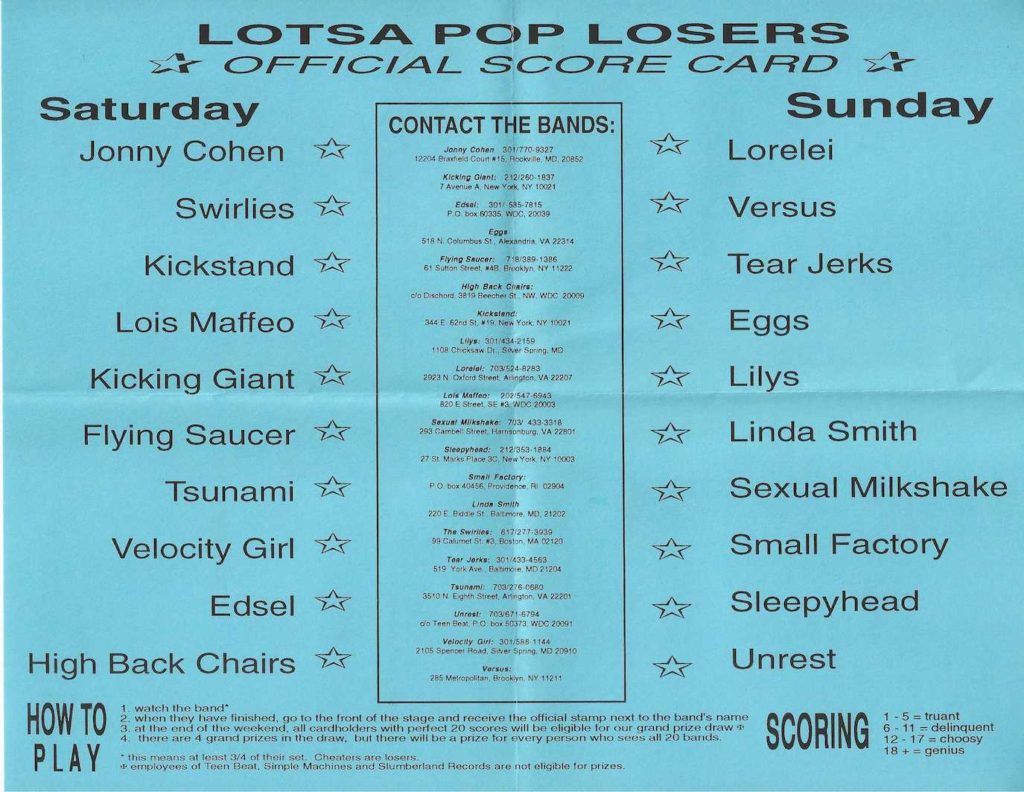
Organizers, what do you remember about putting it together?
Mark: Jenny and Kristin from Simple Machines came up with the idea and were the ring leaders. They then generously asked me and Mike Schulman if Teen-Beat and Slumberland would be involved, respectively. They made tons of cool merch. Trading cards for all the musicians/bands, Lots of Pop Losers t-shirts, posters etc.
Kristin: It’s funny to look back now and realize that there were only eight weeks between playing IPU in Olympia, and Lotsa Pop Losers in DC. You have to remember, this is pre-internet, so all of the organizing with Mark at Teen-Beat and Mike at Slumberland happened in person or on the phone. To add to this, both Jenny and I had full-time, non-rock jobs. So, to me looking back 30 years, the fact that it happened on an eight-week timeline is astounding, just on a logistical level. How did we confirm 20 bands in time to get Peter Hayes to design and for Jeff Nelson to screen a three-color poster that included all the bands’ names? Lots of post-work Big Gulps and late nights.
Jenny: I tend to forget the things that were difficult, particularly so many years out from the event, but in my memory it seemed to come together with very little effort. We were connected to and incredibly inspired by the Dischord scene, who also had a kind of boundless energy for running at things they were curious about. Knowing them made it easy to get the beautiful posters made by Jeff Nelson and Peter Hayes. We were beginning to feel proud of the other labels in the DC area—Teen-Beat and Slumberland. I know there was a lot of mutual admiration among our labels, so it was easy to call Mark and Mike, and just delegate responsibilities for inviting all of these new bands and pulling everything together.
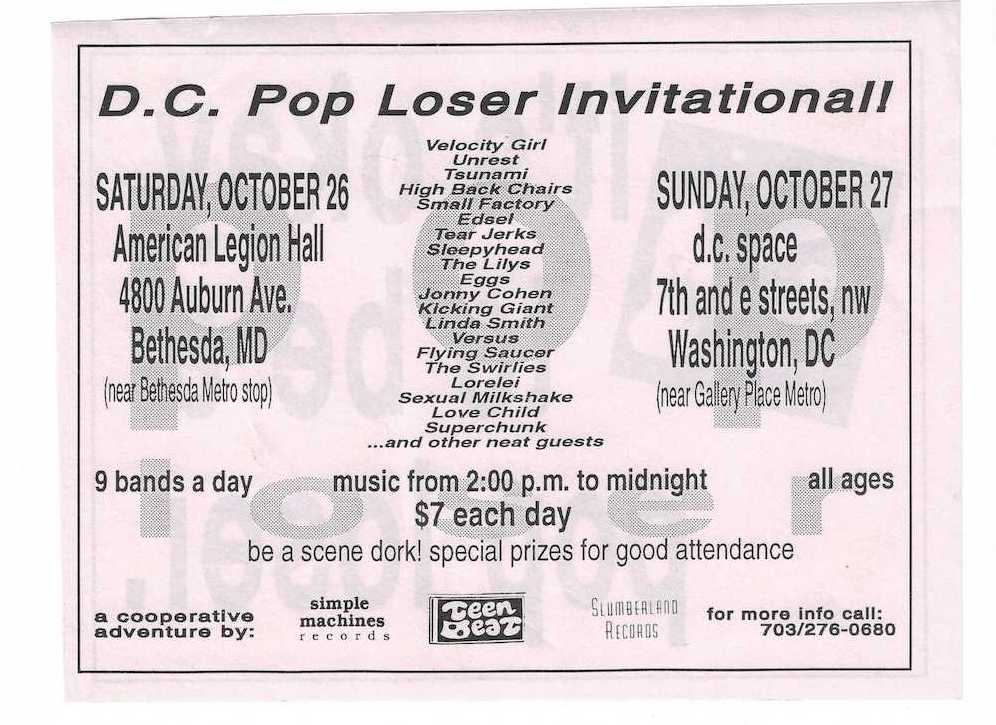
Kristin: Lotsa Pop Losers was an opportunity to add some handmade, community-driven extras. We designed and silkscreened “Teen Slumber Machine” t-shirts. We put together sets of “DC Treasure” baseball cards, highlighting some of the cool people and places in the scene. And the show included an indie rock scorecard, so audience members could run up to the front of the stage to get their card stamped after each band. We’d had some practice with Positive Force shows putting together booklets, and Simple Machines probably had six or eight releases by now, but I’m sure being at IPU, being on tour, reading new zines, buying new 7-inches, and working with Teen-Beat and Slumberland, we were bursting with ideas about all the fun things we could pack into a show. (A sidebar on what was also happening Sept/Oct 1991: I just noticed while looking through some archival folders for this article that we also organized a Positive Force show at the American Legion Hall in Bethesda in the same eight-week period— September 30, 1991—with the Melvins. We got a noise complaint from the police, but instead of stopping, the Melvins continued to play on volume level 1 and stage whispered their lyrics. And, of all things, the famous Nirvana show at JC Dobbs in Philly was the next day— October 1, 1991. I didn’t go up to Philly for this, but Jenny did.)
Jenny: And it’s hard to remember that back then we were touring without (and largely living without) the internet so on the road there was little to do but read, journal and imagine the next amazing things you’d work on when you landed.
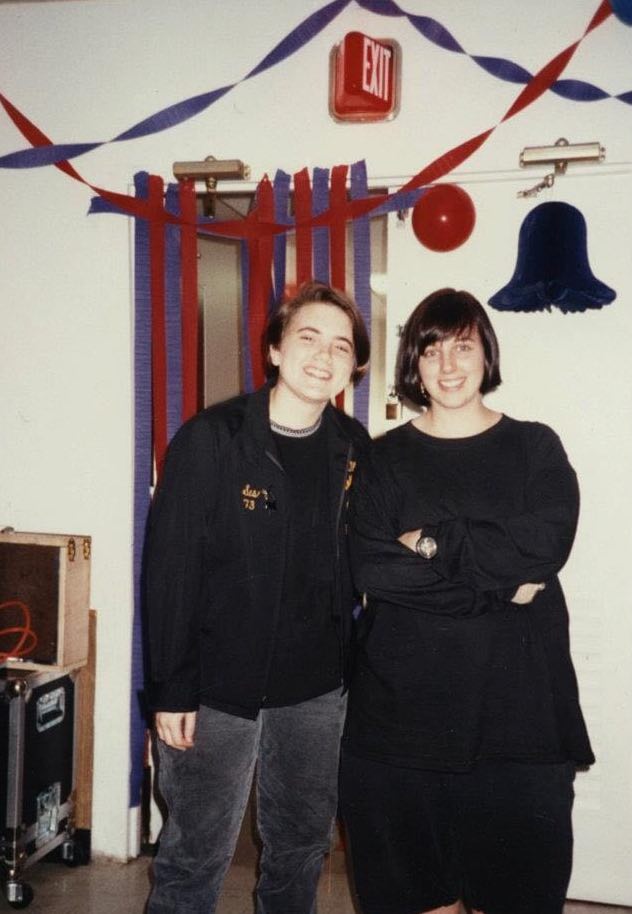
Performers, what did it feel like to be there? What were the fans like?
Erin: Much like with IPU, with so many bands, the venues being small, and the acts themselves being pretty obscure—the fans really were the other musicians. There was not a clear demarcation between the bands and the fans. A lot of mutual admiration society going on, with bands watching each other from the pit. Bratmobile were slated to play, but weren’t able to given that we were all in college and living on 2 different coasts. I did play 2nd guitar with Unrest at the dc space show, which was incredible— they were one of my favorite bands! I played probably 3 or 4 songs with them—I did this twice live—the Lotsa Pop Losers show, and later in Chapel Hill.
Mark: I seem to remember that there were almost as many performers in the audience as there were “fans.”
Michael: This felt a lot like a community event than a fan event. The audience was likely 50 percent people in bands who were playing. That made it more intimate. It made it both low pressure and high pressure at the same time. We always wanted to bring everything we had to every show, and since we were largely playing for peers, the stakes were higher in that regard, but there was also a sense that people understood us so we had less to prove.
Kristin: I remember it being a really joyful, eager, friendly crowd.
Jenny: …and it felt like a lot of the audience were in the other bands. It was a community event. There wasn’t that divide of performer/artist vs consumer/audience.
Kristin: …which was also cool! It was a time when most of these bands were just starting to tour, so we were all pretty excited to watch each other perform.
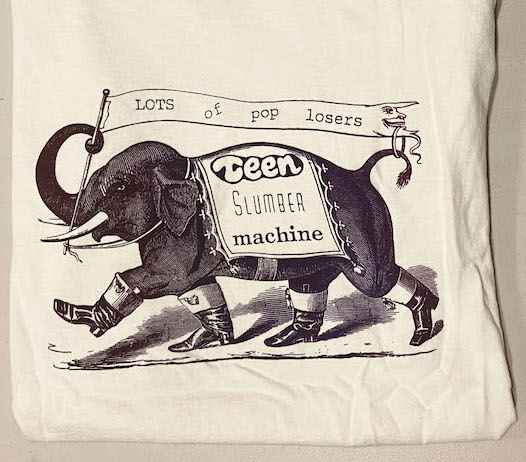
It seemed like an exciting time for the East Coast pop scene. What did the community feel like then?
Jenny: It felt alive with possibility. It wasn’t like we didn’t love the Dischord scene—I was obsessed with the Dischord bands and wouldn’t miss a show—but the next generation of labels were also coming into their own and putting out great records and I loved them too. It felt really exciting. We were still living in the Positive Force house at that time, and there were people who didn’t think it was punk enough and who were very suspicious of the Sub Pop commercialism, which was beginning to influence so much of the independent music scene. Some of our housemates would spend hours arbitrarily deciding which of the pop groups were sufficiently punk, adding logic loopholes exempting the groups they liked. It felt like they were fighting the world’s smallest war and the unnecessary heavy atmosphere was one sign that it was getting time for us to move out into the first Simple Machines house.
Erin: In 1991, with Gen X just starting to be able to take a little tiny piece of the control of the media from Baby Boomers, it felt like everyone I knew in the local punk community was starting to get nationally recognized at the same time. Things like Sassy Magazine (for which I was the Washington Bureau Chief) started to take notice of the DC bands and give them some national press. SPIN and the Washington Post started to write about it more and more, too. This is just about the time Nirvana broke and things got really crazy.
Mark: Small. But there was definitely a connection between the DC and NY/New England bands—like we were doing something new and somehow connected to each other. My band had already been around for 8 or 9 years at this point, so it was interesting and great that we were included in this movement, scene, or whatever it was.
Michael: Having a bunch of bands that we regularly played with and saw at other shows created a pretty powerful sense of community. Everyone in bands that we played with was involved in other creative activities and that created pathways for all kinds of creative connections. I feel like that community made it possible for me to find a foundation to be creative.
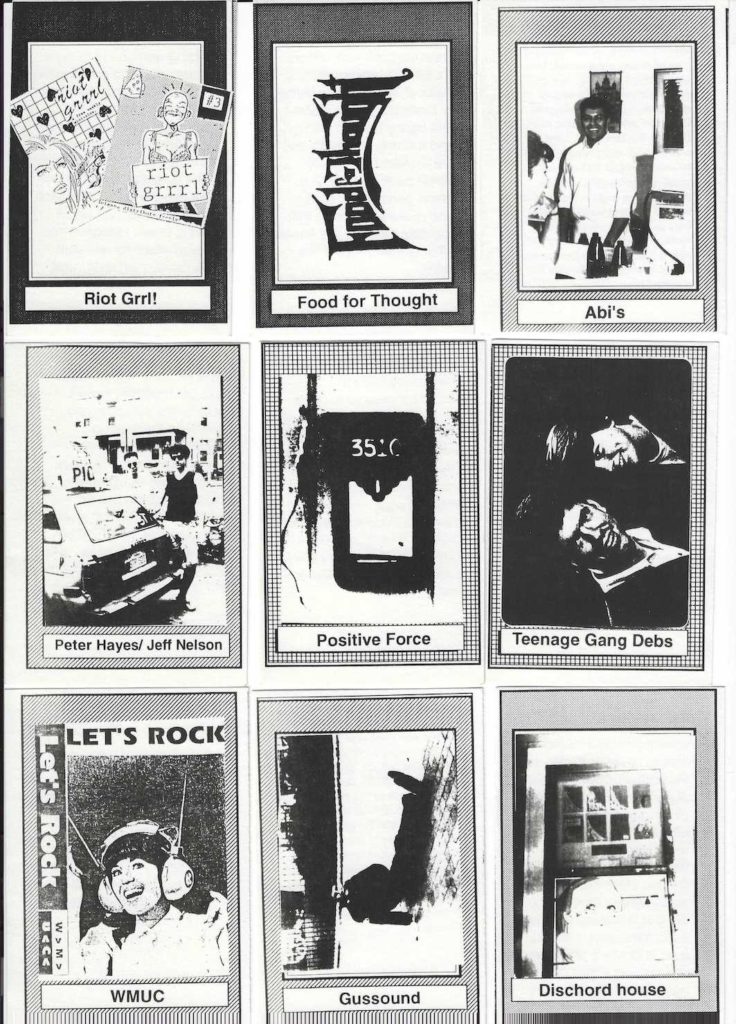
What performances do you remember? New artists discovered?
Mark: Pretty sure this was the first time I saw Versus play. Not only was their set amazing, but they would quickly become my favorite band. One interesting thing about this festival that there were a lot of New York and New England bands… My band had played CBGB and other places like that in New York countless times, but in 1991 we had started playing different venues like the Spiral which was a kind of hub for bands in this new scene.
Michael: Kicking Giant roaring through their set. Unrest being unreal. Lilys.
Jenny: I remember Jonny Cohen had a great set, and it might have been one of the first times we saw Small Factory who were a fan favorite for the VG crew. And, of course, Unrest and Versus, who to this day remain my favorite, favorite bands.
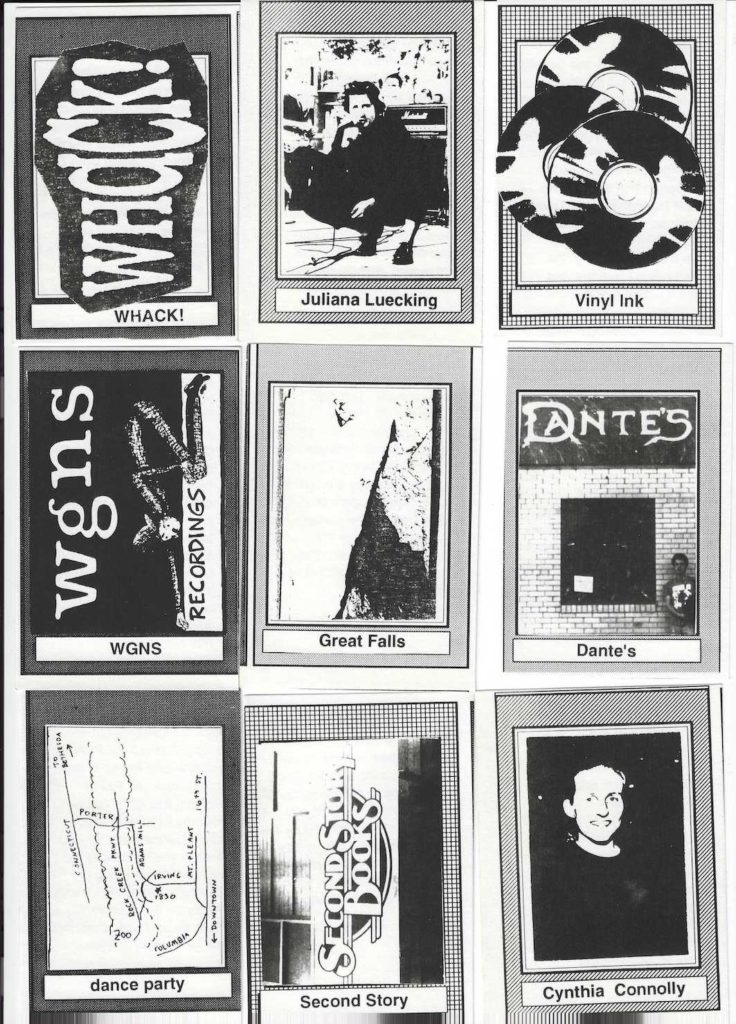
What was the vibe in general?
Jenny: It felt like a new scene. It also felt established … not a beginning, but an actuality. Like “here we all are, of course we are here.”
Kristin: There was also a really great ratio of women performing. DC had a number of women who were either in bands or played important roles in the punk scene. And even though this wasn’t a deliberate plan, it’s affirming to look back and see just how many of the bands playing at Lotsa Pop Losers had women in them.
Mark: The vibe was just one of having fun.
Michael: pleasant low-key calm, with some intense musical moments.
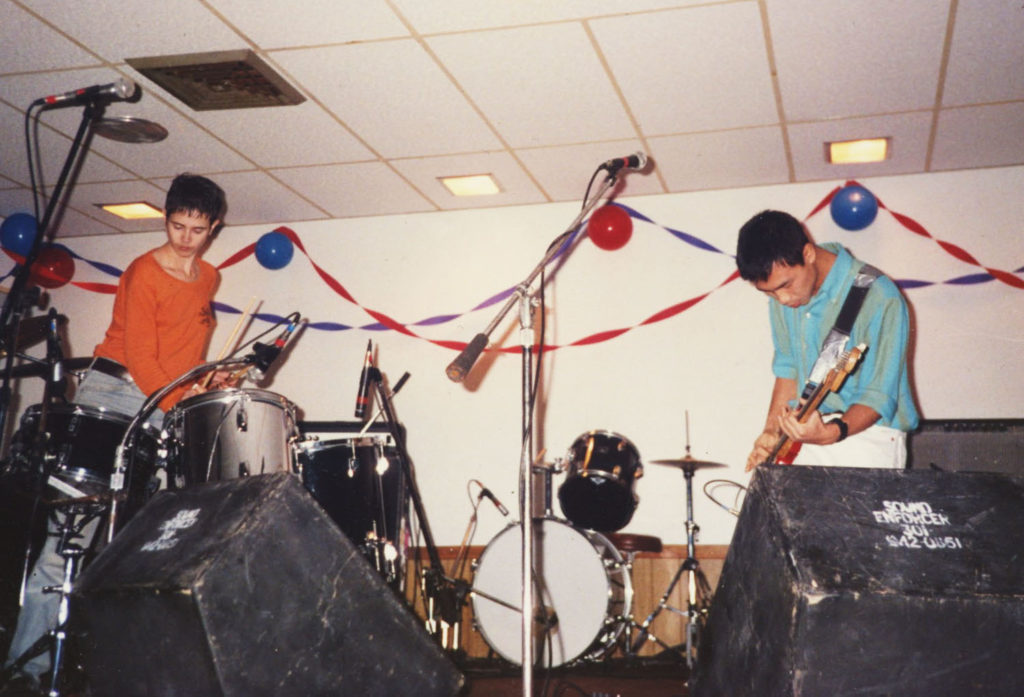
Was it covered by mainstream media then and if so, did they get it?
Jenny: My memory isn’t good here. I think a person from SPIN or Option came down, but we thought it was kind of weird to have mainstream interest. I have a memory that Mark (Jenkins) from the City Paper may have written something.
Kristin: Lotsa Pop Losers might have been even a few months too early for the mainstream music press to be interested in this East Coast indie scene. I feel like the Providence Indie Rock Explosion, which happened about six months later, attracted more music press attention. I believe that was one of Belly’s first shows, and by then you could really feel the momentum building around some indie rock bands.
Michael: I recall seeing some stuff in zines but not really the media.
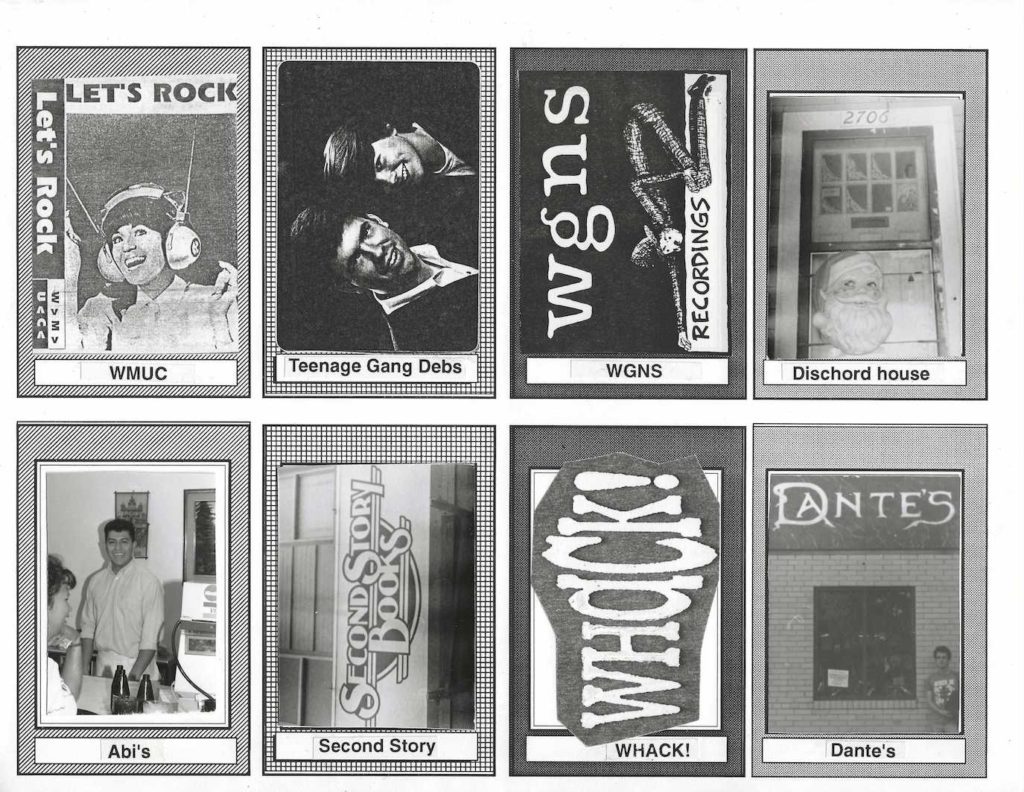
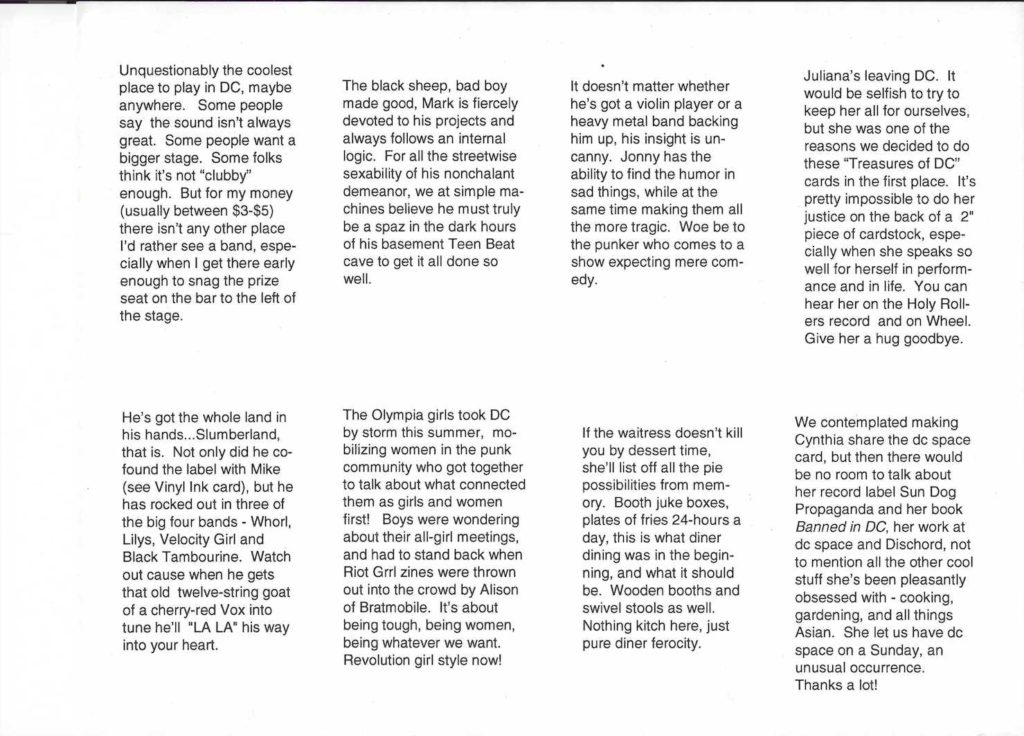
Anything else you remember?
Erin: I was not a fan of the name Lotsa Pop Losers—a play on both Lollapalooza and Sub Pop’s use of “Loser” at the time—because the fest was full of some of the most underground and amazing bands I knew, not to mention the coolest people! No way were any of these people “losers”!
Michael: I remember doing “surrender” with Otis.
Mark: Each label got to choose approximately one-third of the bands that would perform. I also wanted to screen a film, Hippie Porn by Jon Moritsugu, so we did that on the first day at the VFW hall. There was a TV and VHS player set up in the corner and perhaps 2 or 3 people gathered around and watched it before the first band played. I remember it being kind of cold since it was the end of October, but I was still wearing shorts. It always took me a while to change my wardrobe to match the seasons. I also remember not being completely in love with the name of the festival; that it was kind of named after Lollapalooza—and that we were “losers”—ha ha.
Jenny: Looking back 30 years, I think it was just one of those moments when things came together. They happen from time to time where a lot of complementary energy just shows up in the same space. For us that was exactly when a few different labels and bands became intertwined in such a strong way. Out of it came records, tours, friendships. When I finally joined Facebook about five years after it started, someone advised me to only friend people who I would let sleep on my couch. As a couch surfing and couch sharing musician, that was a pretty long list, but when I look at my friends list today, all the LPL alumni are there. It’s awesome to see so many of them are still creating, collaborating and sharing music with the world, and if any of them are ever up in Catskill (Kristin: or near Philadelphia!) you can let them know we’ve actually got a guest room now.
Read this 2013 oral history in Washington City Paper for more quotes about the event!
